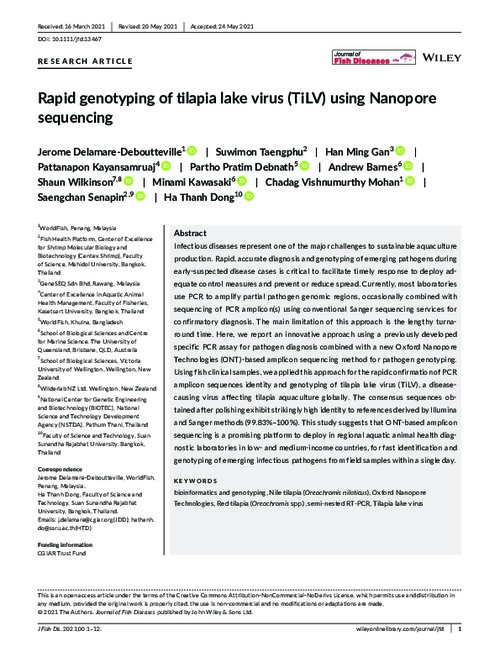Please use this identifier to cite or link to this item:
https://hdl.handle.net/20.500.12348/4706
Rapid genotyping of tilapia lake virus (TiLV) using Nanopore sequencing
| dc.creator | Delamare-Deboutteville, J. | en_US |
| dc.creator | Taengphu, S. | en_US |
| dc.creator | Han Ming, G. | en_US |
| dc.creator | Kayansamruaj, P. | en_US |
| dc.creator | Debnath, P.P. | en_US |
| dc.creator | Barnes, A. | en_US |
| dc.creator | Wilkinson, S. | en_US |
| dc.creator | Kawasaki, M. | en_US |
| dc.creator | Chadag, V. | en_US |
| dc.creator | Saengchan, S. | en_US |
| dc.creator | Thanh, D. | en_US |
| dc.date.accessioned | 2021-04-23T07:21:48Z | |
| dc.date.available | 2021-04-23T07:21:48Z | |
| dc.date.issued | 2021 | en_US |
| dc.identifier.citation | Delamare-Deboutteville J, Taengphu S, Gan HM, et al. Rapid genotyping of tilapia lake virus (TiLV) using Nanopore sequencing. J Fish Dis. 2021; 44: 1491– 1502. https://doi.org/10.1111/jfd.13467 | en_US |
| dc.identifier.issn | 0140-7775 | en_US |
| dc.identifier.issn | 1365-2761 | en_US |
| dc.identifier.uri | https://hdl.handle.net/20.500.12348/4706 | |
| dc.description.abstract | Infectious diseases represent one of the major challenges to sustainable aquaculture production. Rapid, accurate diagnosis and genotyping of emerging pathogens during early-suspected disease cases is critical to facilitate timely response to deploy adequate control measures and prevent or reduce spread. Currently, most laboratories use PCR to amplify partial pathogen genomic regions, occasionally combined with sequencing of PCR amplicon(s) using conventional Sanger sequencing services for confirmatory diagnosis. The main limitation of this approach is the lengthy turnaround time. Here, we report an innovative approach using a previously developed specific PCR assay for pathogen diagnosis combined with a new Oxford Nanopore Technologies (ONT)-based amplicon sequencing method for pathogen genotyping. Using fish clinical samples, we applied this approach for the rapid confirmation of PCR amplicon sequences identity and genotyping of tilapia lake virus (TiLV), a disease-causing virus affecting tilapia aquaculture globally. The consensus sequences obtained after polishing exhibit strikingly high identity to references derived by Illumina and Sanger methods (99.83%–100%). This study suggests that ONT-based amplicon sequencing is a promising platform to deploy in regional aquatic animal health diagnostic laboratories in low-and medium-income countries, for fast identification and genotyping of emerging infectious pathogens from field samples within a single day. | en_US |
| dc.format | en_US | |
| dc.language | en | en_US |
| dc.publisher | Wiley | en_US |
| dc.rights | CC-BY-NC-ND-4.0 | en_US |
| dc.source | Journal of Fish Diseases;44,(2021) Pagination 1491,1502 | en_US |
| dc.subject | oxford nanopore technologies | en_US |
| dc.subject | semi-nested rt-pcr | en_US |
| dc.subject | nile tilapia (oreochromis niloticus) | en_US |
| dc.subject | bioinformatics and genotyping | en_US |
| dc.subject | red tilapia (oreochromis spp.) | en_US |
| dc.subject | Fish | en_US |
| dc.title | Rapid genotyping of tilapia lake virus (TiLV) using Nanopore sequencing | en_US |
| dc.type | Journal Article | en_US |
| cg.contributor.crp | Fish | en_US |
| cg.contributor.funder | CGIAR Research Program on Fish Agri-Food Systems | en_US |
| cg.contributor.funder | Big Data in Agriculture | en_US |
| cg.contributor.project | Inspire Challenge Winner 2019: Rapid genomic detection of aquaculture pathogens | en_US |
| cg.coverage.region | Global | en_US |
| cg.subject.agrovoc | tilapia lake virus | en_US |
| cg.contributor.affiliation | WorldFish | en_US |
| cg.contributor.affiliation | Mahidol University, Faculty of science, Center of Excellence for Shrimp Molecular Biology and Biotechnology | en_US |
| cg.contributor.affiliation | Lab Ind Resource | en_US |
| cg.contributor.affiliation | Kasetsart University | en_US |
| cg.contributor.affiliation | University of Queensland | en_US |
| cg.contributor.affiliation | Independent / Not associated | en_US |
| cg.contributor.affiliation | Suan Sunandha Rajabhat University | en_US |
| cg.identifier.status | Open access | en_US |
| cg.identifier.ISIindexed | ISI indexed | en_US |
| cg.contribution.worldfishauthor | Delamare-Deboutteville, J. | en_US |
| cg.contribution.worldfishauthor | Debnath, P.P. | en_US |
| cg.contribution.worldfishauthor | Chadag, V. | en_US |
| cg.description.theme | Sustainable aquaculture | en_US |
| cg.creator.id | Jerome Delamare-Deboutteville: 0000-0003-4169-2456 | en_US |
| cg.creator.id | Vishnumurthy Mohan Chadag: 0000-0002-2574-284X | en_US |
Files in this item
This item appears in the following Collection(s)
-
Sustainable aquaculture [2717]
